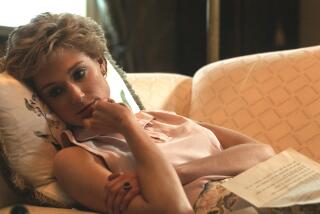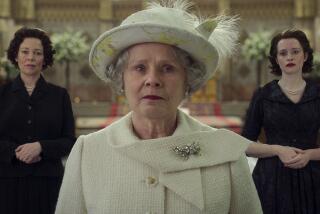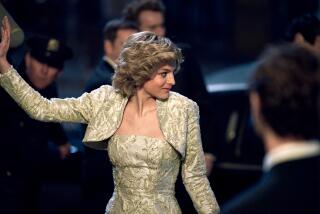Portrait Is Touching and, Yet, Touched Up
There is no dislodging her now. A year after her death, Diana, Princess of Wales, tall, gorgeous, winsome and adored, remains nailed to her pedestal like Jesus to his cross.
U.S. press and infotainers are joining the Brits in noting the first anniversary of the high-speed crash in a Paris underpass that killed Diana and her boyfriend, Dodi Fayed, and their driver, Henri Paul, plunging much of the West into deep mourning and instigating the biggest and wildest media frenzy since the previous media frenzy.
Just as questions about the crash linger, so does intense ardor for its most famous victim. TV’s coverage galore this time includes easily a dozen hours of special programming, enough to satisfy even the most fanatical Dianaphile until the second anniversary rolls around.
NBC contributes its own two hours of curtsying with tonight’s fiercely loyal “Diana,” a thoroughly watchable homage that is nonetheless meticulously tailored to those who prefer their idols high-gloss chamoised and lint free. By the time its closing credits roll, Diana has been so indelibly beatified that her image of 24-karat goodness couldn’t be cracked with a jackhammer.
All that cracks here is the voice of Richard Attenborough, the British filmmaker (his most famous movie is “Gandhi”), who co-produced this biography and which he narrates emotionally, at times on camera in a cardigan, like a royal uncle overcome with grief.
When Attenborough speaks so sadly of “our lost princess,” it brings to mind the ornate cortege of media words that followed Diana to Westminster Abbey for her funeral last Sept. 6 before a reported global TV audience of 1 billion. The enshrinement was complete. As if the actual person were unworthy, instead came eulogies of saintliness that towered over reality.
Or as Michael Levine puts it in “The Princess & the Package,” his fair, thoughtful and readable new book examining Diana’s symbiosis with the media:
“Diana kept wrapping herself in whatever bows and ribbons she thought the public would like. The media packaged and repackaged her as whatever they thought would sell the most. It is most interesting and disturbing that neither thought that what was inside the package was good enough for the public to buy plain-wrapped.”
There’s nothing plain-wrapped about “Diana,” whose blurring euphemisms and tasteful omissions--amid customary footage of the royal courtship and wedding of Charles and Diana, and her subsequent life as a single mother devoted to worthy causes--create a picture whose dots are only partially connected. The package doesn’t open.
As Attenborough has said in interviews, the focus is Diana’s “impact on people,” not her “private life.” In other words, the public Diana minus the nubby footnotes that give a life texture.
We hear, for example, that while still married, Charles retained as “a friend” Camilla Parker-Bowles, with whom it’s generally acknowledged he was having an affair. Diana’s bulimia is mentioned in an almost offhand way and blamed on Charles once telling her, “You’re a little bit chubby, aren’t you?” And given the documentary’s framing of the royal marriage’s demise (“despite the best efforts of therapists and mother figures”), you might surmise that it died of attrition.
As an acquaintance of Diana, Attenborough’s sorrow here is undoubtedly as sincere as the other gleaming testimonials in this biography, which are nice to have on the record, as far as they go. Not very.
No one from the Spencer or royal families is interviewed on this program. Nor is Fergie. Nor anyone, it appears, who might crash this insulated fairy-bubble. In charting interviews, Attenborough has said previously that the producers chose to avoid “the susceptibilities of the very close relations.”
So instead here comes Diana’s friend, Lucia Flecha de Lima. Plus her hairdresser, her makeup artist, her employer when she was a nanny during her Charles courtship, and Diana’s very own childhood nanny, who weighs in on the adult Diana as if she had continued to hang around as a confidant. More effusive than anyone is Hillary Rodham Clinton, who knows a bit about marital dysfunction, this time bolting herself to a bandwagon not likely to collapse under her.
Not that Diana doesn’t deserve a measure of adulation for turning activist and devoting herself to such noble causes as AIDS and land-mine prevention in the latter years of her life. “She could have become just another A-list celebrity,” notes narrator Attenborough. “But Diana realized she could use the people who made her famous, and who photographed every detail of her day”--he means the media--”to give purpose and meaning to her life. She put the burden of her fame to the best possible use.”
In other words, she ultimately did the most with what she had, an admirable trait. But so have many others who remain outside the loop of celebrity.
Given how disparagingly Christopher Hitchens has written of her alleged hypocrisy, you hesitate to bring up Mother Teresa, who died within a week of Diana after laboring in the sainthood business for 68 years. But it’s impossible not to, for although Diana’s good works were thin compared with the famed Catholic nun’s lifetime of assistance to the sick and destitute of India, no two-hour documentaries about Mother Teresa appear on the NBC schedule.
Not enough glam for the big show, you’d imagine.
Levine wonders in “The Princess & the Package,” which is generally favorable to Diana, “how and why . . . this young woman of modest accomplishments became virtually canonized.”
One reason is that venerating her is good commerce--notably her posthumous emergence as a merchandising cash cow, a brand name bankable in both the marketplaces of Diana products, whose sales have been said to reach $200 million annually, and the media, where just about anything bearing her face delivers the goods.
Another is a widespread yearning for role models and public figures to look up to--which in the United States equates these days to a cynical and disillusioned nation possibly seeing Diana’s pristine memory as just the ticket at a time when Bill Clinton is crashing to earth.
A woman says tonight about Diana: “She was all the marvelous, glamorous things that women wanted to be.” Is she speaking of Diana the person, though, or Diana the image? And when love is mentioned in connection with the masses’ adoration of Diana, is it love of the person or love of “the princess of hearts”?
What do we even mean by love, by the way? Is it the same love that young females express for heartthrob Leonardo DiCaprio? The same love that the Rev. Jerry Falwell and his spiritual allies declare for the homosexuals they condemn? Shakespeare’s love, that of caring for another more than yourself?
How much of Dianaphilia is truly heartfelt, and how much is generated by the media? And does it even matter now that Diana has been airbrushed into history?
* “Diana” airs at 8 tonight on NBC (Channel 4).
More to Read
Sign up for our Book Club newsletter
Get the latest news, events and more from the Los Angeles Times Book Club, and help us get L.A. reading and talking.
You may occasionally receive promotional content from the Los Angeles Times.








